The farm of Michal Grabiec was located at the edge of the village of Niwiska, not far from the forest. The house stood on the hill a little way from the main road that leads from Kolbuszowa to Rzochow and Mielec. The remains of the Sandomierz Wilderness stretched further on the horizon.
The house was built of unhewn trees using a construction method that used coal. The trees were stacked with bricks of coal, and the bark was stripped off.

1800’s home in Kolbuszowa Skansen
The main room of the house had a large window facing south and a smaller one facing north. The home had a great room, a loft, and a pantry type storage area. The yards were fenced in separating one garden from another. The walls were packed with moss stuck together with clay and whitened each year with lime.
Instead of a wood floor, there was just a packed clay surface to walk on. In the corner was a large two-chambered stove, the larger part used for baking bread. The smaller one had a sheet of metal on it where meals were prepared.
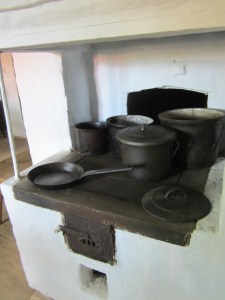
On the walls were many pictures of saints. Under the pictures hung a special beeswax “Gromnica” votive candle which was blessed on the Marian feast of the Presentation of Our Lord. This Holy day was on February 2 and called Candlemass Day. The candle was to be lighted on only two occasions. In the summer the people lit them to ask God to keep the danger of fire and lightning strikes away. The candles were also lit if a person inside the house was dying and all would gather to say prayers and lay hands on the person. ( Note from Donna Gawell: The tradition of the Gromnica continues to this day and I was given one when I visited my cousins in 2016.)
Along the walls were two or three beds where the family slept. When there were many children, the loft was used by them, especially in the winter. Next to the stove was a wide bench where the family could sit and sometimes it was even used for sleeping. The younger children often sat on the ground to eat.
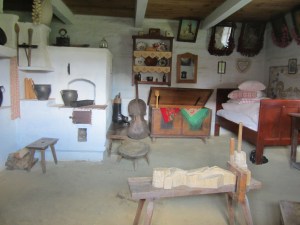
Clay Floor Home from Kolbuszowa Skansen
Near the window was a large table on which there was always a loaf of bread. The type of wheat used in the bread varied with the seasons and the type of harvest they experienced. If they had no wheat, there just wasn’t any bread. Next to the table was a large bench and small stools where the family sat to eat, and they enjoyed the aroma of the wheat of the Polish fields. In the corner near the door was a cabinet for the utensils. They were displayed in the cabinet with some beautiful clay bowls with painted flowers and roosters.
There were large and small bowls with the largest used for mixing the cabbage with peas and spiced with bacon, or some old beef−it was tasty! On the cupboard were earthen pots for drinking water, milk, or “coffee.” The coffee was made from the burnt crusts and crumbs of wheat that were milled, and milk was added.
Next to the cupboard there stood a jug for bringing water from the well. Next to that was a wooden basin for cleaning the dishes. The main room was swept with a broom made of twigs from the birch trees. Lovely flowers such as geraniums and myrtle were by the windows.
Typical meals consisted of beet soup with potatoes and a little bacon fat. Other times, instead of beet soup, the family was served milk with the potatoes. Cooking took place in the kitchen or in the fireplace where there stood an iron grate and on it a metal pot where potatoes, buckwheat, noodles, and cabbage were boiled.
In the morning and early evening, all members of the family knelt to say prayers aloud.
If a household was well to do, they might own a few store bought plates. Usually, there were only earthen dishes and each household made their own plates out of clay. Sometimes, these clay dishes and plates were taken to the town market in Kolbuszowa to be sold.
In Michael Grabiec’s house, there was a storage pantry−, there were two doors where you could go out to the north or south to get to the yard. In the pantry were doors to the small closet where barrels for grain and a crock for baking bread were stored.
Church clothes and home clothes hung on a hook. They also had chests for clothing. Sometimes beautiful chests had a place in the dwelling. They were beautifully painted, and they held skirts, sleeveless jackets, shirts, trousers, for church and sometimes, if people had it, money.
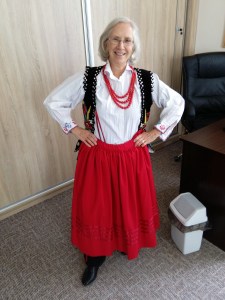
Folk Costume from Niwiska Hupka Manor
The beds were beautifully made with a comforter and with feather pillows (a lot of geese were raised.) Sometimes there were small pillows set very high.
The house was covered with a thatched roof. The hay was bundled and sewed into the roof. In the center of the roof was a chimney, from which smoke came out whenever we were burning something.

Michael’s house had a stork’s nest on the roof. The storks would fly in during the spring season and circle over their nest as if to greet it. There they raised their young. The older ones would bring frogs, snakes, and fish to their young ones. It was believed whoever had a stork’s nest on their house would have good fortune for the family. Even to this day, the villagers consider a stork as a sign of good luck.
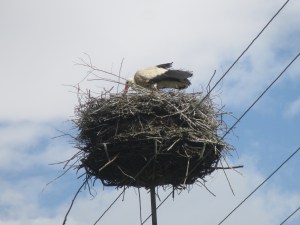
The homes were whitened on the outside with lime. Next to Michael’s house were pear trees. There was a very old one named “Palka” which means “the stick.” They also had apple trees, and four were called “Tartars.”
Wheat was sown in the adjacent field. There were two big rocks by a tree and were used as grinding devices by swiveling the stones with the grain resulting in quern ground meal. Wheat was also milled into flour for bread and a second kind of wheat was intended for noodles or pierogies. Another wheat was allowed to ferment and made into beet broth.
The home was landscaped with a wooden fence around the garden. From the north side, there stood two large beekeeper’s hives, a new one, and an older one. The bees also made a home in the recess that formed in one of the wider trees. In the fall, Michal would collect the honey and the children would be thrilled to lick the utensils and clean their fingers of fresh honey. Once, Aunt Ludwika (Louise Domino) ate so much honey for herself it was said it began to come through the skin on her belly!
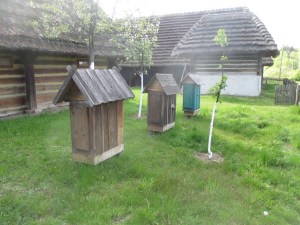
Old Beehives from Kolbuszowa Skansen
Flowers, raspberries, chamomile and wild thyme grew in the garden. The flowers bloomed all summer long, In the fields, Michal sowed a lot of Tartarian buckwheat because when the buckwheat bloomed, the bees made a lot of honey.
By each farm was a well for drawing water. Michal’s well never seemed to have much water in it. The livestock, horses, and oxen were watered in the pond because it was low-lying and well supplied with water. For drinking and cooking, we had to bring water from a neighboring farm’s well, and it was far.

Pond at Kolbuszowa Skansen
Next to the house in the yard were farm structures−a barn for livestock or oxen, a field which was a sun drying area, where with flails the grain was watered down, and the space next to it was for grain. Next to that was a tool shed for things that were necessary for work in the fields like a wooden plough, wooden weapons, a cart used for plowing. On the other side were areas for hay or straw.

My cousin Maria and her husband Jozef showed us how to use a sickle and wheat thrasher

Beyond the farm stretched fields and roads. Further still beyond the fields were the forests.

Wojceich the horse from Niwiska
Update on water distribution in the late 1990’s: The water problem had been solved; nobody carried water since a waterworks was built in Niwiska. Water is connected to every home, so if Michal and his three wives were alive, they wouldn’t have to carry their water.